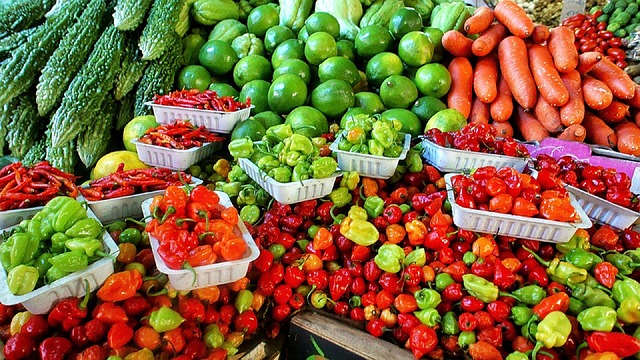
What is The Dirty Dozen? Read on to find out…
At Modern Kids Design, we’re “all in” when it comes to buying organic food, but we know many of you like to mix it up and pick and choose between organic and nonorganic. Because of this, we recommend that when choosing how to spend your grocery budget, shoppers should consider buying organic when it comes to the most heavily pesticide-laden fruits and vegetables, better known as The Dirty Dozen.
Every year, the Environmental Working Group (EWG) puts out a list it calls “The Dirty Dozen.” This list contains the fruits and vegetables USDA testing has found to have the highest concentrations of pesticides. EWG recommends consumers purchase the organic varieties of the Dirty Dozen to reduce the amount of pesticides they ingest—and we agree.
The Environmental Working Group is one of our nonprofit partners which specializes in research and advocacy in the areas of toxic chemicals, agricultural subsidies, public lands, and corporate accountability. And when they highlight the importance of avoiding pesticides or using adequate sunscreen, we tend to listen.
EWG’s 2016 Dirty Dozen
This year, the EWG’s Dirty Dozen actually had 14 fruits and veggies that contained traces of multiple pesticides. If any of these fruits or veggies are on your shopping list, purchase organic varieties to reduce the amount of pesticides.
- Apples: Often found at the top of the Dirty Dozen list, apples are sprayed with numerous pesticides to protect from pests and fungi. Plus, because the apples contain a high concentration of pesticides, apple products like apple juice and applesauce tend to be high in pesticides, too.
- Bell peppers: All colors of sweet bell peppers tested high in pesticides. Before picking some up to add to your kabobs for dinner, consider purchasing organic varieties or an alternative.
- Celery: Crisp celery comes with a cost. Many farmers use numerous pesticides to get their celery to market. Either opt for other crispy greens like raw broccoli or seek out organic celery to curb your pesticide consumption.
- Cherry tomatoes: Tomatoes can be difficult to grow in your garden, even when that’s all you’re growing. Imagine trying to grow a whole crop of them. To get the most yield, farmers crank up the pesticides to protect their plants. Rather than tossing those pesticides onto your salad, purchase organic varieties.
- Collard Greens/Kale: These hearty greens are seeing too much spray action, even though they shouldn’t need it. An organic farmer’s market is a great place to score some organic greens that haven’t been pestered. Collard Greens and Kale are part of the “plus category” in EWG’s Dirty Dozen, meaning they aren’t top twelve (yet), but consumers should beware.
- Cucumbers: You may be able to peel off the skin to remove some of the pesticides on a cucumber, but it’s better and safer to just purchase organic varieties.
- Grapes: Grapes and grape products such as raisins can have up to 50 different pesticides on them, especially imported varieties.
- Nectarines: Imported nectarines carry more pesticides than domestic nectarines—and both have more than organic varieties.
- Peaches: Yes, nonorganic peaches can be purchased inexpensively, but they come at a cost. Like apples, these tree fruits are extensively sprayed.
- Peppers: Another “plus category” mention, hot peppers are increasing in pesticides. Get your spice from organic varieties to avoid adding unnecessary chemicals to your favorite dishes.
- Potatoes: Potatoes have been found to have high traces of pesticides, however, their cousin, the sweet potato, does not. If you don’t want to purchase organic potatoes, add more sweet potato to your diet. Not only will you get fewer pesticides, but you’ll get all the benefits of the amazing sweet potato.
- Snap peas: Snap peas are great in a stir-fry, but adding in dozens of pesticides? Not so great. Organic varieties or an alternative can help.
- Spinach: We can’t imagine Popeye would be happy to hear that Spinach made the Dirty Dozen list, but he’d switch to organic if he heard.
- Strawberries: A repeat offender, strawberries are sprayed to protect from fungi. This year, however, strawberries top the EWG’s list. Here’s why.
“Clean” Foods
Some foods considered “clean” (i.e., found to have little-to-no pesticide residue) are OK to buy nonorganic. These also make good alternatives to the dirty dozen if you’re unable to buy organic varieties.
- Asparagus
- Avocados
- Cabbage
- Cantaloupe
- Grapefruit
- Kiwi
- Mangoes
- Onions
- Pineapples
- Sweet potatoes
Other Organics to Add to the Shopping List
In addition to the Dirty Dozen, we recommend you buy organic, free-range, wild-caught, or antibiotic-free versions of any foods your kids love to eat, including:
- Baby food
- Peanut butter
- Chicken, pork, and beef
- Fish
- Eggs
- Milk
Not everyone can afford to buy organic all the time, and that’s ok. By prioritizing the Dirty Dozen, you can reduce the amount of pesticides in your family’s food and still stay within your food budget. If you want to further maximize your dollar, consider shopping locally at a farmer’s market or joining a CSA.
As always, thanks for reading and, if there is something you’d like to read about on the blog, please tell us. We enjoy hearing from you at healthyliving@modernkidsdesign.com 🙂

